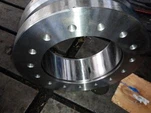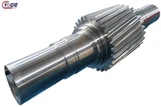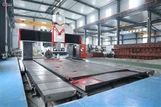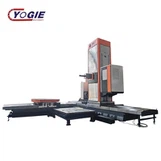Luoyang Yujie Industry&Trade Co., Ltd is one of the most experienced manufacturers and suppliers of ball mill bearing pedestal in China. Please feel free to buy cheap ball mill bearing pedestal for sale here from our factory. All customized products are with high quality and competitive price.
Ball mill Bearing Pedestal
Products Description
A bearing pedestal, also known as a bearing housing or bearing stand, is a component used in mechanical systems to support a rotating shaft and its associated bearings. It provides a stable and rigid platform for the bearing to ensure proper alignment, reduce vibration, and support the load of the rotating shaft.
The main purpose of a bearing pedestal is to hold the bearing securely in place and protect it from external contaminants, such as dust, dirt, and moisture. It also helps in dissipating heat generated by the bearing during operation to prevent overheating.Bearing pedestals are typically made of metal, such as cast iron or steel, which provides strength and durability. They come in various shapes and sizes depending on the specific application and the type of bearing being used.The design of a bearing pedestal may include features such as bolt holes for mounting to a machine frame or base, lubrication channels or grease fittings for proper lubrication of the bearing, and seals or covers to prevent the ingress of contaminants.
Products Description

Functions of bearing pedestals
Here are the key functions of a bearing pedestal:
Bearing Support: The main purpose of a bearing pedestal is to provide a stable and secure support for the bearing. It holds the bearing in place and prevents excessive movement, ensuring proper alignment and positioning within the machinery.
Load Distribution: The bearing pedestal helps distribute the load and forces acting on the bearing, such as radial and axial loads, to the surrounding structure. It prevents concentrated stresses and helps maintain the integrity of the bearing and the machine.
Alignment: Bearing pedestals often incorporate features that aid in the alignment of the bearing with respect to other machine components. Proper alignment is crucial for the smooth operation and longevity of the bearing, as misalignment can lead to increased wear, vibration, and reduced efficiency.
Contaminant Protection: Bearings are susceptible to damage from dust, moisture, and other contaminants. The bearing pedestal provides a protective housing around the bearing, minimizing the risk of contamination. It may include seals or shields to further enhance the protection against external elements.
Lubrication Management: Bearings require lubrication to reduce friction and wear. Some bearing pedestals include provisions for lubricant input, output, or recirculation. These features allow for efficient lubrication of the bearing, ensuring proper operation and extending its service life.
Temperature Management: In certain applications, bearings can generate heat due to friction or other factors. The bearing pedestal may incorporate cooling or heat dissipation mechanisms to manage the temperature of the bearing, preventing overheating and potential damage.
Mounting and Installation: Bearing pedestals typically provide mounting surfaces or flanges for attaching the pedestal to the machine frame or structure. They often include holes or slots for fasteners, making it easier to install or replace bearings when necessary.
The features and advantages of bearing pedestals
Bearing pedestals offer several features and advantages that contribute to their importance in mechanical systems. Here are some key features and advantages of bearing pedestals:
Products Description
►Support and Stability: Bearing pedestals provide a stable and rigid support structure for the bearing, ensuring proper alignment and reducing vibrations. This helps maintain the integrity of the rotating shaft and enhances the overall stability of the system.
►Bearing Protection: Bearing pedestals enclose the bearing, protecting it from external contaminants like dust, dirt, and moisture. This shielding prevents premature wear and damage to the bearing, thereby extending its lifespan.
►Load Distribution: Bearing pedestals distribute the load of the rotating shaft evenly onto the supporting structure. By distributing the load effectively, they prevent excessive stress on the bearing and help minimize the risk of failure or damage.
►Heat Dissipation: During operation, bearings generate heat due to friction. Bearing pedestals are designed to dissipate this heat efficiently, preventing overheating and ensuring the bearing operates within its optimal temperature range. This feature contributes to the longevity and reliability of the bearing.
►Easy Installation and Maintenance: Bearing pedestals are typically designed with bolt holes or mounting provisions that facilitate easy installation onto machine frames or bases. They also often include features like lubrication channels or grease fittings for convenient maintenance, allowing for proper lubrication and inspection of the bearing.
►Versatility: Bearing pedestals are available in various sizes, shapes, and materials to accommodate different types of bearings and mechanical systems. This versatility makes them suitable for a wide range of applications across industries.
►Durability: Bearing pedestals are commonly made of robust materials like cast iron or steel, which provide strength and durability. They are built to withstand heavy loads, shocks, and environmental conditions, ensuring long-lasting performance.
►Noise Reduction: By minimizing vibration and ensuring proper alignment, bearing pedestals contribute to reducing noise and improving the overall smoothness of the mechanical system.
Summary
In summary, bearing pedestals offer essential features and advantages that support the smooth operation, protection, and longevity of bearings in mechanical systems. They provide stability, load distribution, and heat dissipation while facilitating easy installation and maintenance.
Machinery processing methods of bearing pedestals
The manufacturing of bearing pedestals involves various machinery processing methods to achieve the desired shape, dimensions, and functionality. Here are some common machinery processing methods used in the production of bearing pedestals:

Description
Casting: Casting is a widely used method for manufacturing bearing pedestals. It involves pouring molten metal, such as cast iron or steel, into a mold with the desired shape and dimensions of the pedestal. Once the metal solidifies, the mold is removed, and additional machining processes may be performed to refine the surface finish and ensure proper dimensions.
Machining: Machining processes, such as milling, turning, drilling, and grinding, are employed to shape and finish the bearing pedestal. CNC (Computer Numerical Control) machines are often utilized for precise and automated machining operations. These processes remove excess material, create holes and threads, and achieve the required tolerances and surface finish.
Boring: Boring is a machining process that enlarges or refines existing holes in the bearing pedestal. It is commonly used to create precise bearing seats or accommodate other components in the pedestal.
Tapping: Tapping is the process of creating internal threads in the bearing pedestal. It involves using a tap tool to cut threads into pre-drilled holes, allowing for the attachment of fasteners or other components.
Welding: In some cases, bearing pedestals may be fabricated by welding together multiple components or plates. Welding processes, such as arc welding or gas welding, are utilized to join the parts, ensuring strength and structural integrity.
Surface Treatment: Surface treatment methods, such as painting, powder coating, or plating, may be applied to bearing pedestals for aesthetic purposes, corrosion resistance, or enhanced durability. These processes help protect the pedestal from environmental factors and improve its appearance.
Heat Treatment: Heat treatment processes, such as annealing or quenching and tempering, may be employed to optimize the mechanical properties of the bearing pedestal. Heat treatment can enhance the pedestal's strength, hardness, and toughness, improving its performance and durability.
Quality Control: Throughout the manufacturing process, quality control measures are implemented to ensure the bearing pedestal meets the required specifications and standards. This may involve dimensional inspections, surface quality checks, hardness testing, and other quality assurance techniques.
Summary
These machinery processing methods are employed based on the specific design requirements, material properties, and production capabilities. Manufacturers utilize a combination of these methods to produce high-quality bearing pedestals that meet the functional and performance needs of various applications.
About us

Luoyang Yujie Industry &Trade Co.Ltd located in Luoyang City, one of the main heavy industrial bases in China. We specialize in the production of nonstandard machinery parts. For the nonstandard machine parts, we can produce gears, shafts, sprockets, molds, rollers, pulley, mining machine parts, etc as per customer drawing and requirements.
Contact us
Do you have any specific questions about bearing housing (pillow block bearing) or bearing pedestal ? Contact Yogie!Our sales engineers will work with you from start to finish to ensure that your project is completed to your requirements.
![]()
tel: +86-379-65163600
![]()
phone: +86-15036387078
![]()
envelope: sales@yujieindustry.com
![]()
fax:+86-379-65163600
![]()
address:No.9, Sanxi Road, Jianxi Industrial Park, Luoyang City, Henan, China 471003
![]()
whatsapp: 8615036387078
Hot Tags: ball mill bearing pedestal, manufacturers, supplier, factory, customized, cheap, price, in stock, for sale, Bearing seat


















